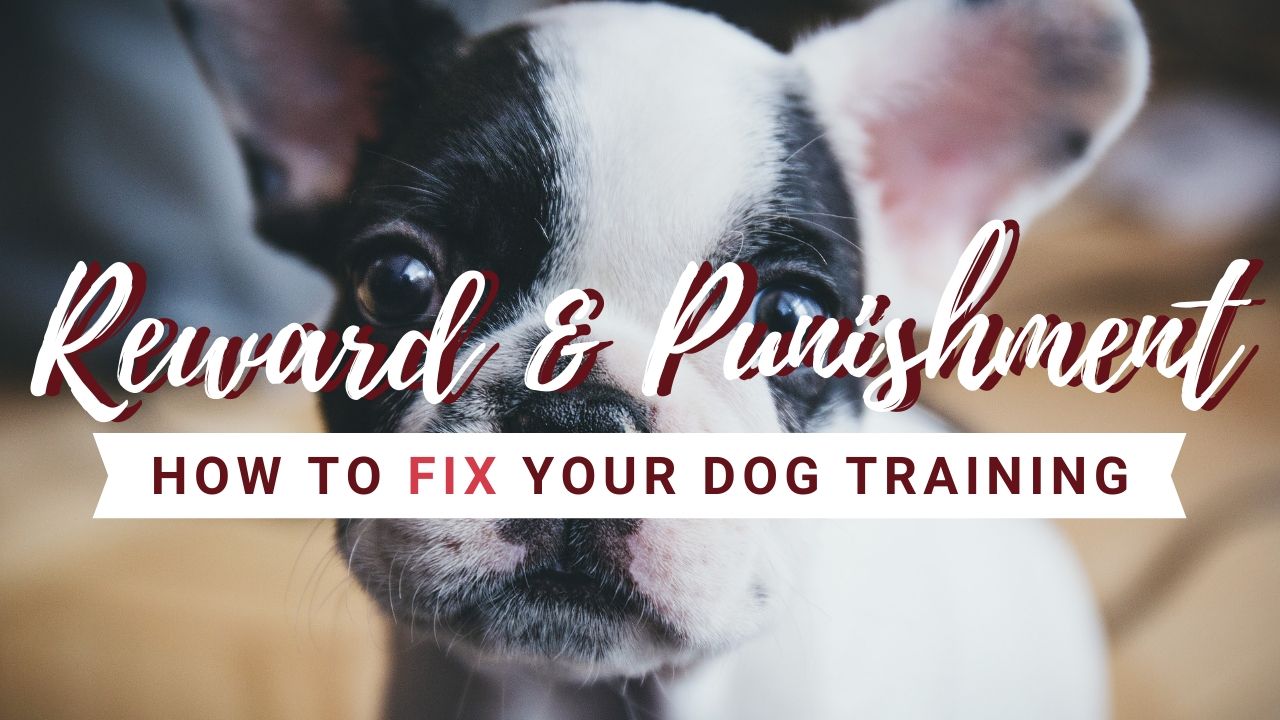The 4 Quadrants of Dog Training: And How They’re Wreaking Havoc With Your Progress!

B. F. Skinner is well-known in the world of dog training for developing the theory of operant conditioning – in layman’s terms: the idea that a dog’s behaviour will be determined by its learned consequences. It may sound straightforward, but it’s the foundation of everything we do in dog training today! Professional trainers refer to these consequences applied by trainers as the 4 quadrants of dog training.
“What is Love, but another name for the use of positive reinforcement?” – B.F. Skinner
What Are The 4 Quadrants of Dog Training?
An easy way to think about the 4 quadrants of dog training, is to remember that all consequences are either reinforcing, or punishing. A reinforcing consequence will cause your dog to be more likely to repeat the behaviour that caused the consequence. A punishing consequence will make the behaviour that caused it, less likely to be repeated.
In addition to this, all consequences are either positive or negative, purely in the mathematical sense! So all consequences of a dog’s behaviour will either add something to his world, or remove something from his world.
Put these two ideas together, and you get the 4 quadrants of dog training:
One – Positive Reinforcement:
This means something rewarding is ADDED to your dog’s world, and it’s something that’s more likely to make your dog repeat the behaviour. An example of this in action could be that you ask your dog to sit, they perform the desired behaviour, and so you give them a piece of chicken. The consequence of sitting, was that chicken was added to the dog’s world and, because they like chicken, they’re more likely to sit again the next time you ask them. They learn that sitting brings the good stuff!
Two – Negative Reinforcement:
This means something aversive is REMOVED from your dog’s world, and as a consequence, the dog is more likely to repeat the behaviour. For this to work, there would need to be something unpleasant in your dog’s world already, so that the removal of it would be considered an improvement on the situation to your dog! An example could be that the dog is wearing a choke chain which is pulled tight until the dog sits, and then the chain is loosened. The loosening of the chain is reinforcing because it removes the dog’s discomfort, and therefore increases the likelihood they’ll sit next time. They learn that sitting removes the pain.
Three – Positive Punishment:
This means something aversive is ADDED to your dog’s world… but this time it’s something that will make your dog less likely to repeat the behaviour. Positive punishment is therefore used to deter unwanted behaviours, and was the go-to approach only a couple of decades ago. An example of positive punishment in action could be: you catch your dog chewing up the sofa, so you hit the dog. You have introduced pain as a consequence of chewing, and therefore punished the behaviour; it is less likely to occur again.
Four – Negative Punishment:
This means something rewarding is REMOVED from your dog’s world, and the removal of that thing will make your dog less likely to repeat the behaviour that caused this consequence. An example could be that you and your dog are playing together, but your dog bites down too hard on your skin – to apply negative punishment, you get up and leave the room. When you return, your dog is less likely to bite you hard, because this behaviour caused the removal of his playmate! They learn that biting makes the fun stop.
When Reinforcement and Punishment Go Wrong…
There’s no denying Skinner knew what he was talking about when it came to dog training, but a well-versed trainer will tell you, it’s just not as simple as all that. For the above to work, the following must also be true:
- The dog must fully understand exactly which behaviour he performed that caused the consequence, so he can apply his learning to it
- We as owners must properly understand what our dogs find punishing and reinforcing, in order to appropriately increase or decrease the likelihood of certain behaviours.
Here’s a couple of examples of how getting the above two points wrong can totally mess up what you think you’re teaching your dog, without you even realising!
Accidental Punishment
Imagine you have taken your dog to the park to practise your recall skills. Your dog is off sniffing all the wonderful smells that a park full of trees has to offer a dog, and then you give your recall cue. He recognises it and dutifully bounds back towards you, and to reward him, you ruffle his ears, pat him on the head, tell him he’s the best dog in the world, and then pop his lead on.
If your dog loves physical contact, you’ve probably done a great job of using positive reinforcement to reward his excellent recall. But you’d be amazed how many dogs ‘tolerate’ being petted, as opposed to actually enjoying it. If your dog is one of these, you’ll actually find you’ve just used positive punishment. As a result of answering his recall cue, he had an unpleasant experience… if this is repeated enough for him to associate it with the recall, you’ll find his recall sure to get worse! Likewise, by putting his lead on straight after recalling him, you also applied negative punishment to the dog who loves to run free. As a result of answering his recall cue, he’s lost his freedom!
Accidental Reward
That’s how accidental punishing can wreak havoc with your training… but what about accidental rewarding? If you have a dog who habitually jumps up at people, it could well be that you’re accidentally rewarding them for it. Most people react to an unwanted hug from a large-breed dog by shouting, shoving the dog down, and maybe even moving or running away if dogs really aren’t their cup of tea. You know what that says to a dog? LET’S PLAY! Barking, wrestling and chasing are right up there on a puppy’s list of awesome play behaviours to engage in with a littermate or friend… so when Fido jumps up at you excitedly and you shout, push him down and move away, he sees that an invitation to play, ACCEPTED!
As hard it may be to carry out, your best bet is to freeze and ignore the dog entirely until they get bored and back off, or simply plough on through them, and busy yourself with the usual activities of removing your shoes and coat, putting the kettle on, etc. until they lose interest – that way you’ve rewarded nothing!
Misapplied Learning
And what about if your dog applies the correct rationale to whether he’s being rewarded or punished… but applies this learning to the wrong stimulus? Aversive dog training collars provide an easy example of how things can go disastrously wrong in this way. Imagine you use an electric correction collar to help train your dog to stay nearby when off-lead. Every time your dog runs off too far, or ignores your recall, you activate their collar, and they receive an electric shock as a positive punishment. But what if the reason your dog strayed from your side was because they had spotted another dog in the distance? What if, instead of associating the pain of their collar with running away from you, they associate it with the appearance of the other dog? Very quickly, your dog will no longer want to play with other dogs… instead he’ll be terrified of them, and may resort to aggressive outbursts to speedily remove dogs from his environment, for fear of receiving that same painful punishment.
Which Behaviours Should We Pay Attention To?
Here’s the hard part. Your dog is making choices All. The. Time. And whether those choices are reinforced or punished, will inadvertently determine whether those behaviours end up being repeated day in, day out, or eventually disappear from his repertoire altogether.
The other thing to remember about our dogs, is that there are so many punishing and reinforcing things going on in the world that we, as owners, do not even instigate. A counter-surfing dog finds a leftover sandwich and eats it whilst you’re at work? Counter-surfing has been positively reinforced. A dog barks at a scary-looking delivery guy at the door, and then the delivery guy leaves? Barking at the door is negatively reinforced!
I challenge you to try and keep track of every choice your dog makes over the next 24 hours, and whether you think he was reinforced or punished for making that choice. Think about all the situations in which the environment reinforces or punishes your dog before you even get a look in, and really think about what your dog finds punishing and reinforcing – you may have to challenge your own preconceptions here!
Lots of people think their dogs enjoy things, that their dogs actually tolerate… and likewise plenty of people will converse wildly with their dog over how naughty they’ve just been, when nine times out of ten all that attention is thoroughly enjoyed by the company-craving dog!
When your dog kept hassling you for attention all evening – what did you do? When he finally took himself to bed and laid down quietly… was he punished or reinforced? Think about every choice, and every consequence… and you’ll discover that small tweaks to your training schedule can make a big difference!
Want to take a more coordinated approach to your dog training, and put your knowledge on the 4 quadrants of dog training, and how best to apply them, to good use? Check out our full range of printable dog training trackers, planners and guides right here!
Wondering how on earth you could possibly reward EVERY good choice your dog makes, without your dog gaining weight, fast? Check out our Ditch the Bowl article, on how you can take all the value in your dog’s everyday dinner, and put it to good use!
Need more help with your dog training? Check out our printable planning resources right here, and follow us on Instagram and Facebook for daily tips!







